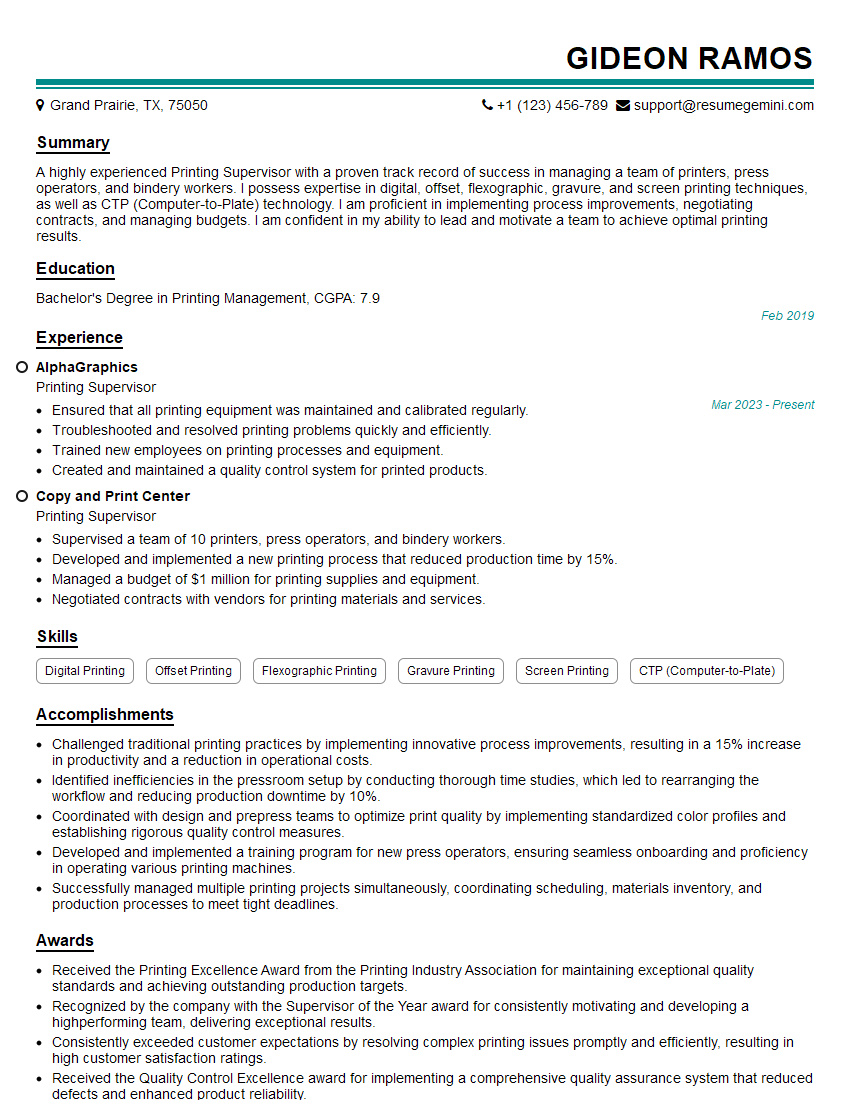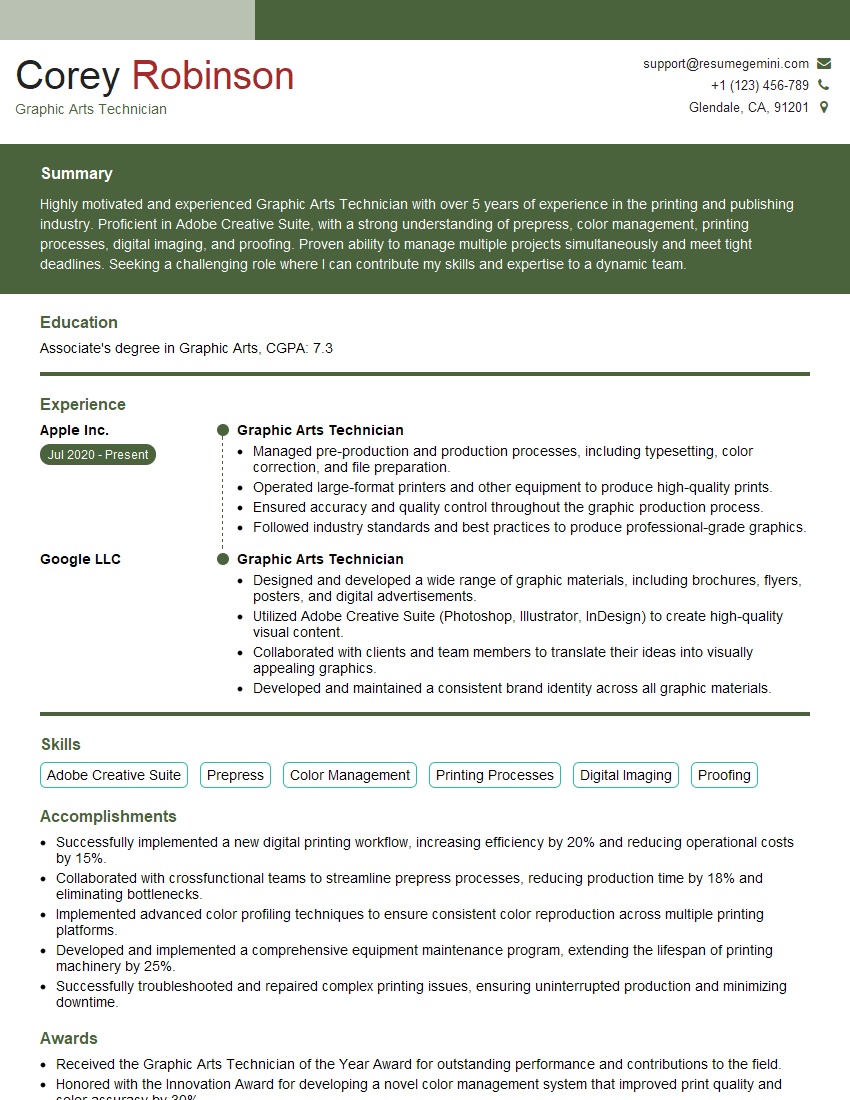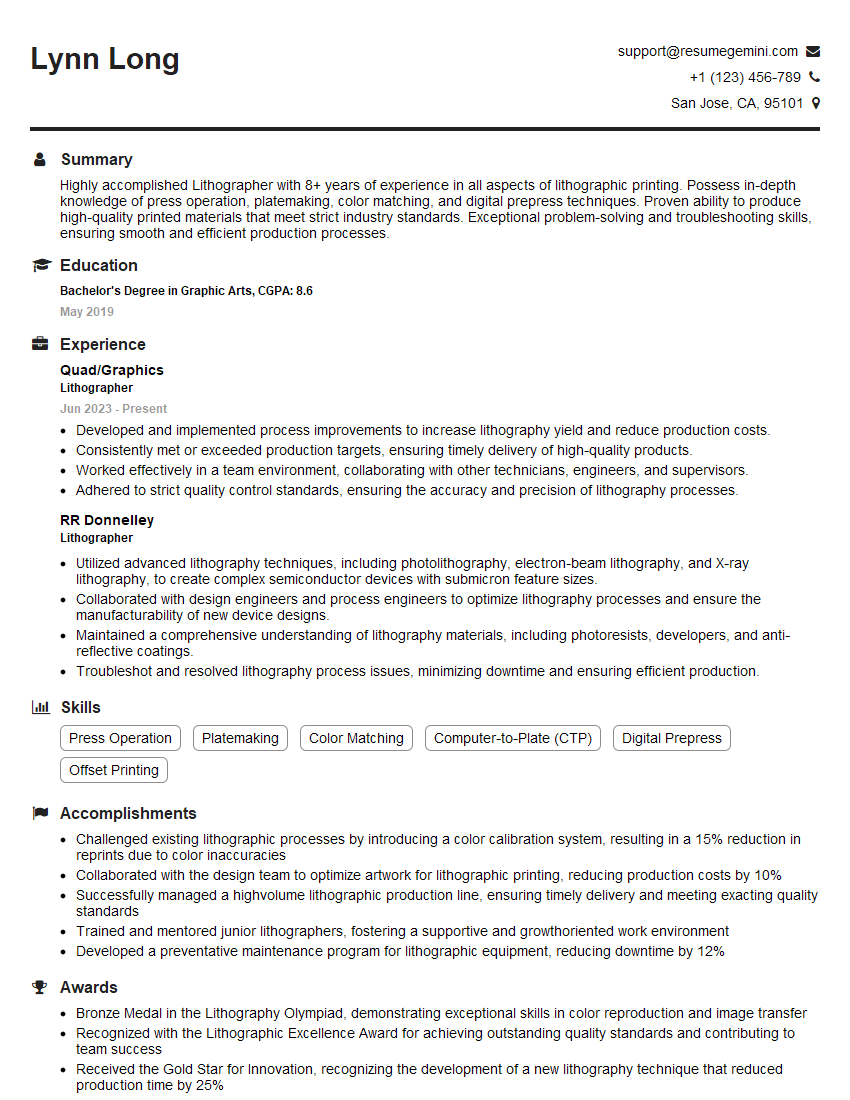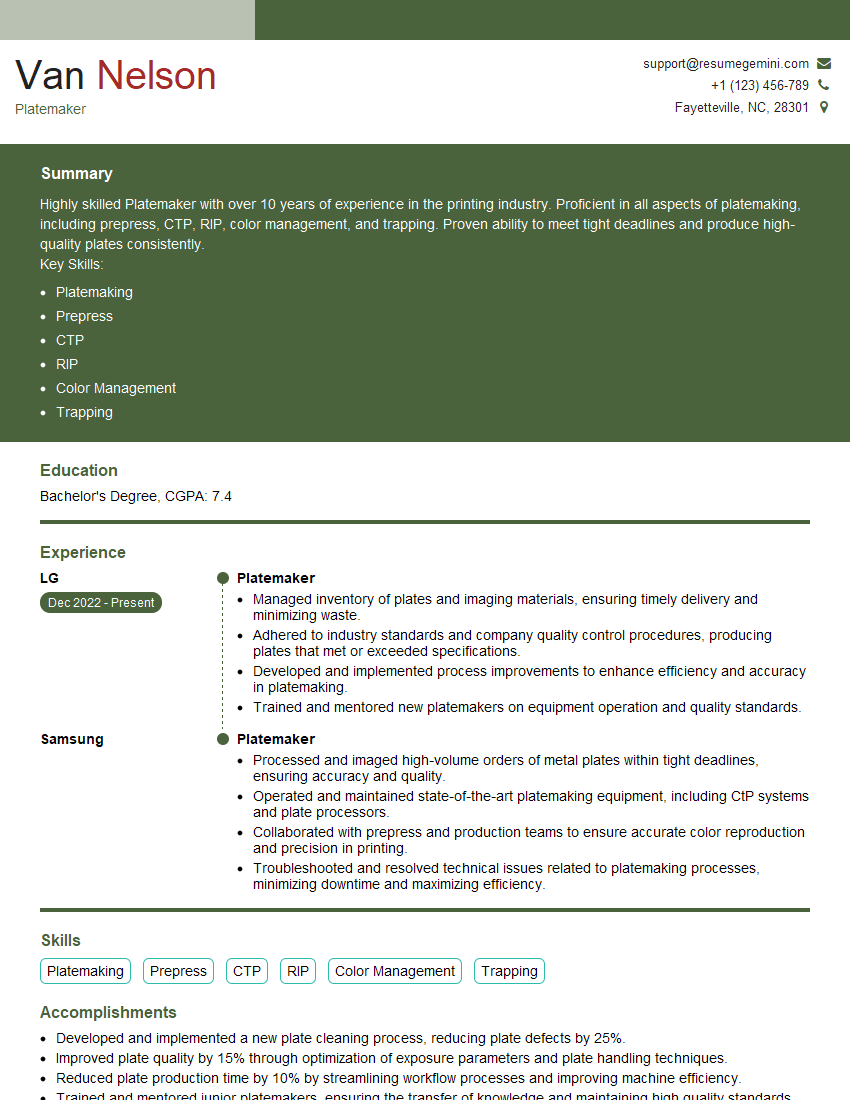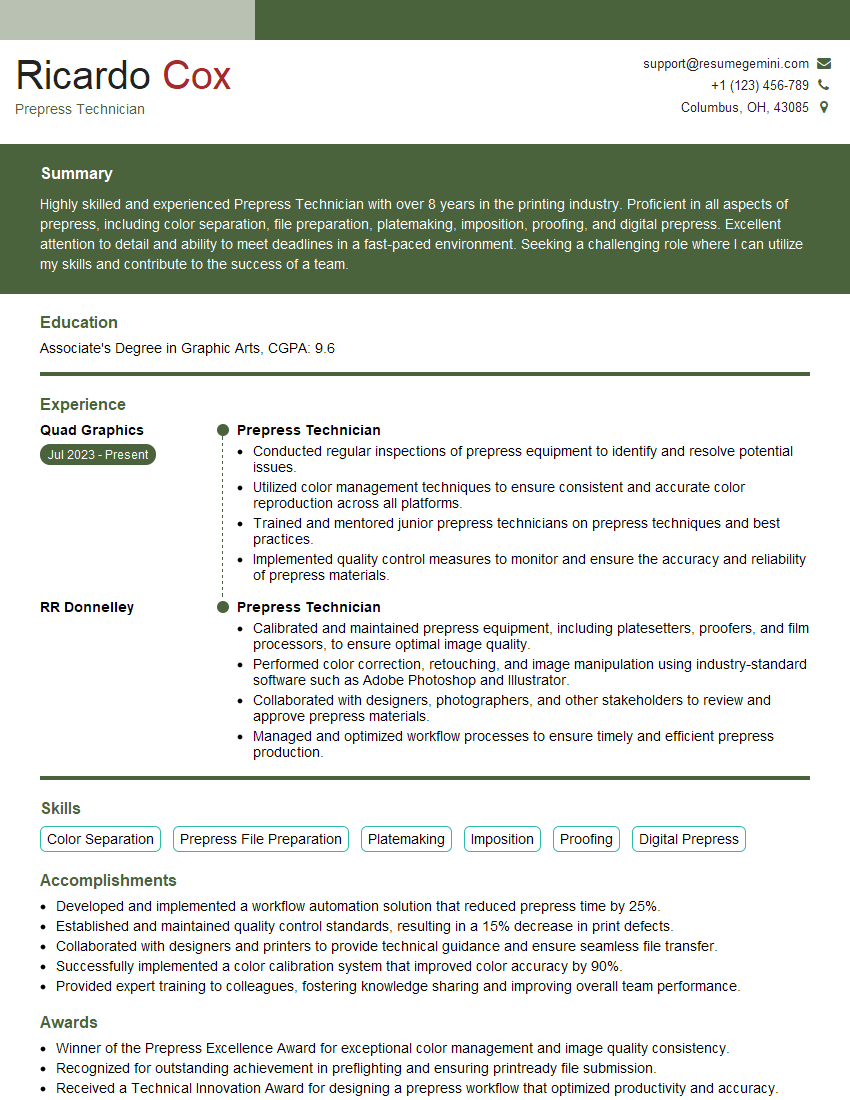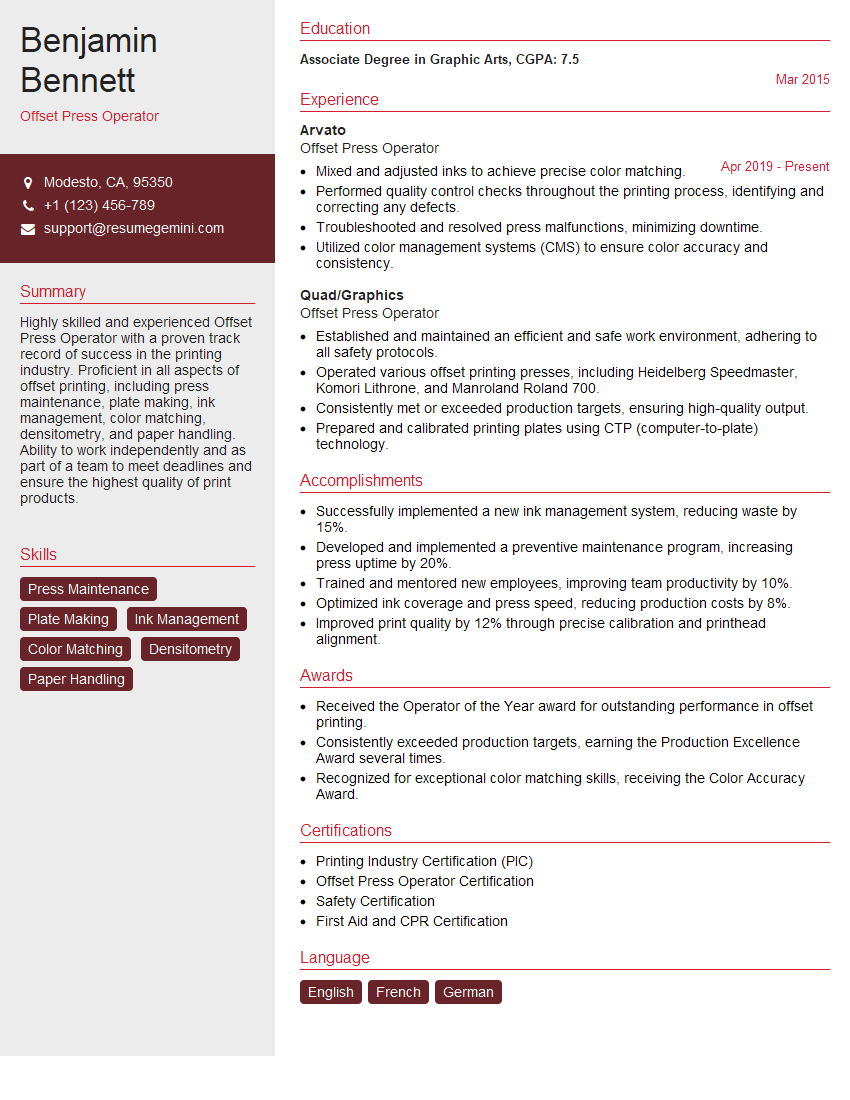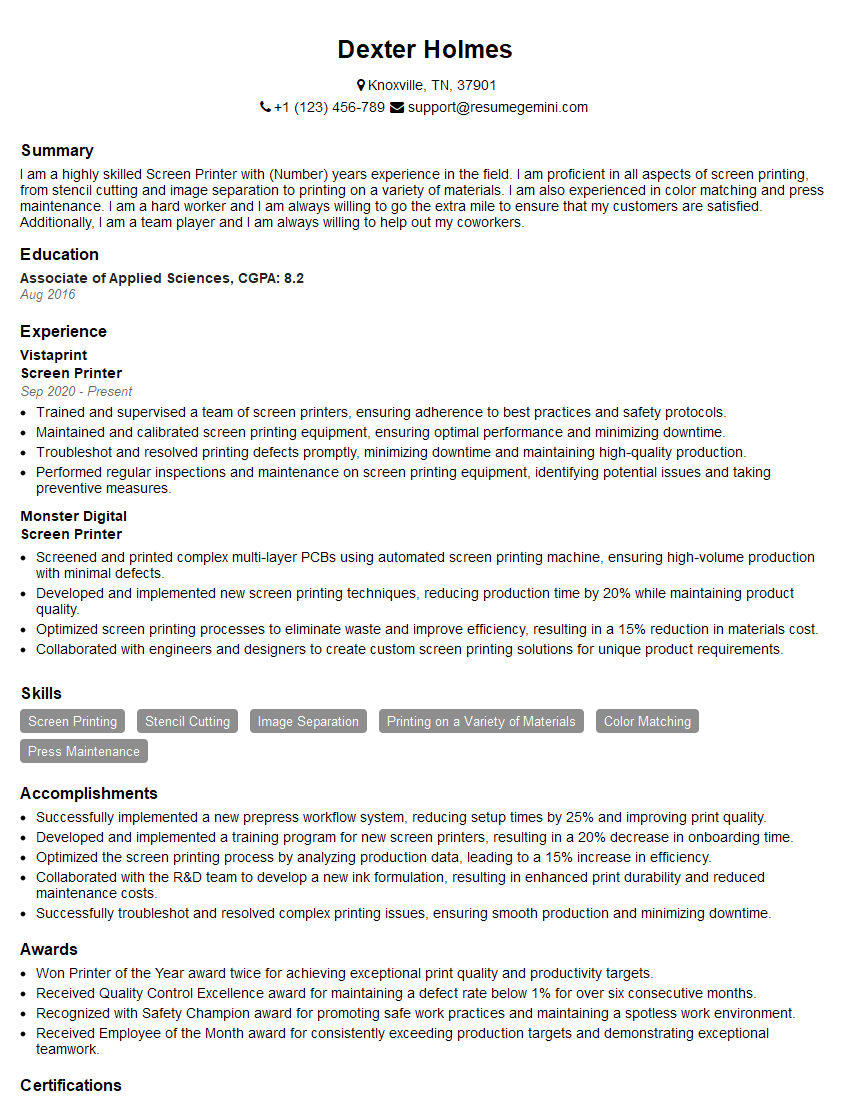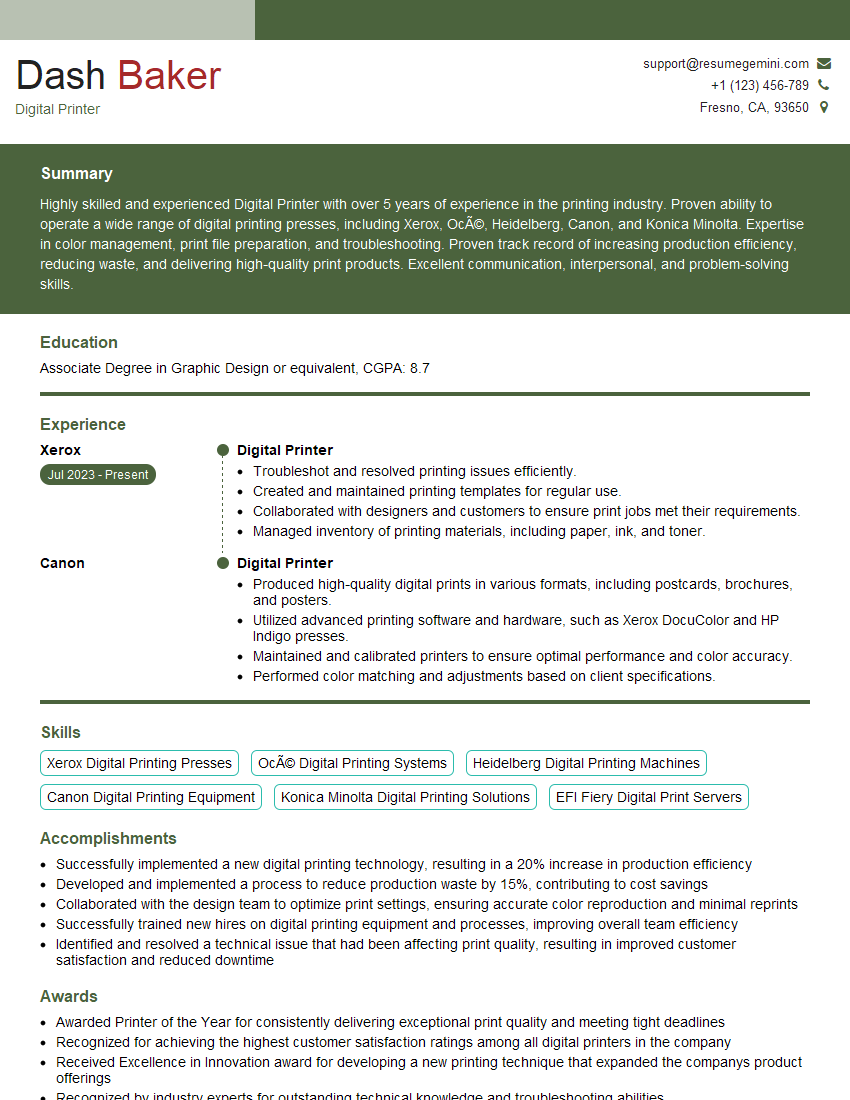Preparation is the key to success in any interview. In this post, we’ll explore crucial Proficient in using platemaking safety equipment interview questions and equip you with strategies to craft impactful answers. Whether you’re a beginner or a pro, these tips will elevate your preparation.
Questions Asked in Proficient in using platemaking safety equipment Interview
Q 1. Describe the safety precautions you take when handling platemaking chemicals.
Handling platemaking chemicals requires meticulous safety practices. My approach always begins with a thorough understanding of the Safety Data Sheets (SDS) for each chemical. This provides crucial information on hazards, handling, and emergency procedures. I always wear appropriate Personal Protective Equipment (PPE), including chemical-resistant gloves, eye protection, and a lab coat. Work is conducted in a well-ventilated area or under a fume hood to minimize inhalation risks. Spills are addressed immediately using the designated absorbent materials and neutralizing agents outlined in the SDS, followed by proper disposal. For example, when working with highly alkaline developers, I’m extra cautious about skin contact and always use a secondary pair of gloves as an extra precaution.
- Always consult the SDS: This is the cornerstone of chemical safety.
- PPE is paramount: Never compromise on eye protection, gloves, and appropriate clothing.
- Ventilation is key: Minimize exposure to fumes.
- Spill response is crucial: Know the proper procedures before an incident occurs.
Q 2. What are the common hazards associated with operating a CTP imager?
Operating a Computer-to-Plate (CTP) imager presents several potential hazards. The primary concern is laser exposure. CTP imagers utilize high-powered lasers to expose the plates, posing a risk of eye damage. This is why it’s crucial to never open the imager during operation or while the laser is activated. Additionally, the high voltage components inside the machine present an electrical shock hazard. Improper maintenance or handling can lead to malfunction and injury. Finally, the chemicals used in the processing of CTP plates also present risks, as outlined in the previous answer. Think of it like this: the imager is a precision instrument with potential for severe injury if safety precautions are not strictly followed.
- Laser Safety: Never access the internal components while the machine is on or the laser is active. Always follow the manufacturer’s lockout/tagout procedures during maintenance.
- Electrical Hazards: Avoid contact with internal components, and ensure the machine is properly grounded.
- Chemical Hazards: Handle developer, fixer, and other processing chemicals according to the SDS.
Q 3. Explain the proper procedure for disposing of used plates and chemicals.
Proper disposal of used plates and chemicals is crucial for environmental protection and workplace safety. Used plates are typically collected separately and given to a licensed recycling facility specialized in handling photographic materials. This ensures responsible recycling or proper disposal of chemicals like heavy metals or other environmentally hazardous components. Spent chemicals, such as developer and fixer, must never be poured down the drain. Instead, they are collected in clearly labeled containers, neutralized if necessary (according to the SDS), and then disposed of according to local environmental regulations and in compliance with hazardous waste management guidelines. Often we use specialized containers and a waste management company to handle this process.
- Recycling: Use approved recycling facilities for used plates.
- Chemical Neutralization: Neutralize spent chemicals before disposal.
- Hazardous Waste Compliance: Adhere to all local and national environmental regulations.
Q 4. How do you ensure the safety of others working in the platemaking area?
Ensuring the safety of others in the platemaking area is a top priority. This involves establishing and enforcing clear safety protocols, including mandatory PPE use, proper chemical handling procedures, and awareness of the potential hazards associated with the equipment. Regular safety training is crucial. I actively participate in sharing knowledge, demonstrating proper techniques, and reminding colleagues about safety protocols. In addition to this, a clean and organized workspace is essential; clutter can lead to accidents. I regularly inspect the area and report any safety hazards to my supervisor. We also conduct regular safety audits and keep an eye out for any colleagues who may be in need of assistance.
- Safety Training: Regular training for all personnel.
- Clear Protocols: Established and enforced safety procedures.
- Communication: Open communication about hazards and safety concerns.
- Cleanliness: Maintaining a clean and organized workspace.
Q 5. What are the safety protocols for handling and storing unexposed plates?
Unexposed plates are sensitive to light and must be stored correctly. They are kept in light-tight containers or boxes, away from direct sunlight or other strong light sources. The storage area should be clean, dry, and free from dust or other contaminants that could affect the plate quality. The plates are typically stored at room temperature and away from any heat sources. Improper storage could lead to degradation of the plates making them unusable and creating waste. Imagine leaving film out in the sun – the same principle applies here.
- Light-tight Containers: Store plates in darkness to prevent premature exposure.
- Clean and Dry Environment: Protect plates from contaminants.
- Appropriate Temperature: Store plates at room temperature, away from heat.
Q 6. Describe your experience with different types of platemaking equipment.
My experience encompasses various platemaking technologies. I’m proficient with both conventional platemaking processes using thermal plates and also highly experienced with CTP (Computer-to-Plate) systems using different types of plates like violet laser plates and UV plates. I’ve worked with various manufacturers’ equipment and have a strong understanding of the differences in processing requirements for each type of plate. This includes a good understanding of the chemistry involved, exposure times and techniques for optimal results. For example, I’ve worked extensively with the Agfa, Fuji, and Kodak systems and their respective processing chemicals and plate types.
Q 7. What are the safety features of the platemaking equipment you have used?
The platemaking equipment I’ve used incorporates several important safety features. CTP imagers usually have interlocks that prevent access to the laser area while the system is operational. Many systems incorporate emergency stop buttons readily accessible in case of unexpected events. The chemical processing units often have safety features such as leak detection systems and automatic shut-off mechanisms. Additionally, many newer machines provide visual and audible warnings to alert operators to potential hazards. Regular maintenance and safety inspections ensure that these safety features remain functional and effective. Think of it like a car’s safety features—regular maintenance is essential for their effectiveness.
- Interlocks: Prevent access to hazardous areas during operation.
- Emergency Stop Buttons: Provide immediate shut-down capabilities.
- Leak Detection Systems: Minimize chemical spills.
- Warning Systems: Audible and visual alerts for potential hazards.
Q 8. How do you identify and report unsafe conditions in the platemaking area?
Identifying and reporting unsafe conditions is paramount in maintaining a safe platemaking environment. My approach involves a proactive and systematic process. First, I visually inspect the area regularly, looking for anything out of the ordinary – spills, damaged equipment, cluttered walkways, inadequate lighting, or malfunctioning safety equipment. Secondly, I actively listen for unusual noises from machinery that might indicate a problem. Thirdly, I use checklists to ensure all safety protocols and equipment checks are consistently adhered to.
If I identify an unsafe condition, I immediately report it using the established company procedure. This typically involves documenting the hazard (location, nature, potential risk), taking photos if necessary, and notifying my supervisor or the safety officer. I ensure the area is secured to prevent accidents until the hazard is addressed. For example, if I notice a chemical spill, I’d immediately cordon off the area with caution tape before reporting it.
Q 9. What are the emergency procedures in case of a chemical spill?
Chemical spills require immediate and controlled response. Our emergency procedures are clearly defined and regularly practiced through drills. The first step is always to evacuate the immediate area and alert emergency services, following company protocols. This ensures the safety of everyone present. Next, we use the appropriate spill kit for the specific chemical involved. This kit usually includes absorbent materials, neutralising agents (if required), protective gear, and disposal bags. We contain the spill, prevent its spread, and then carefully neutralise or absorb the chemical according to the Safety Data Sheet (SDS) instructions for the specific chemical. Finally, proper disposal of contaminated materials is crucial, following all relevant regulations and the SDS instructions.
For example, an acid spill would require a different approach than an alkaline spill. We wouldn’t mix incompatible chemicals which could lead to a dangerous reaction. The SDS provides critical information in handling and neutralizing each substance safely.
Q 10. Explain the importance of personal protective equipment (PPE) in platemaking.
Personal Protective Equipment (PPE) is crucial in platemaking because we deal with hazardous chemicals, sharp tools, and heavy machinery. PPE acts as a barrier, protecting us from potential harm. Ignoring PPE can lead to serious injuries, such as chemical burns, eye damage, cuts, or hearing loss. Wearing appropriate PPE is not just a safety regulation; it’s a personal responsibility. It demonstrates a commitment to protecting oneself and one’s colleagues. This includes not only physical protection but also preventing long-term health issues caused by exposure to certain chemicals.
Think of PPE as your ‘second skin’ in a potentially hazardous environment – providing an extra layer of defense.
Q 11. What types of PPE do you use when working with platemaking chemicals?
The specific PPE used depends on the task and chemicals involved. However, common PPE includes:
- Chemical-resistant gloves: These protect hands from chemical contact, and the type of glove depends on the specific chemicals being used (e.g., nitrile for many chemicals, neoprene for solvents).
- Safety glasses or goggles: Essential for protecting eyes from splashes and fumes.
- Lab coat or apron: Protects clothing from chemical spills.
- Respiratory protection: Depending on the chemical, respirators with appropriate cartridges might be needed to filter out harmful vapors or dust.
- Hearing protection: If working with loud machinery.
- Steel-toe boots: To protect feet from falling objects.
Before beginning any task, I always consult the relevant SDS to ensure I’m wearing the correct PPE for the chemicals I’ll be handling.
Q 12. How do you inspect platemaking equipment for safety hazards before use?
Before using any platemaking equipment, a thorough inspection is vital. This involves checking for visible damage such as cracks, leaks, loose parts, or frayed wiring. I’d also ensure all safety guards are in place and functioning correctly. I inspect for proper grounding to prevent electrical shocks. For machinery, I’d check for proper lubrication, ensuring it runs smoothly and efficiently without unusual noises. This preventative maintenance helps prevent accidents and ensures the equipment is functioning optimally and safely.
For example, before operating a plate processor, I would check the chemical levels, ensure the machine is properly grounded, and verify the safety interlocks are functioning correctly before starting.
Q 13. Describe your experience with lockout/tagout procedures in platemaking.
Lockout/Tagout (LOTO) procedures are crucial for preventing accidental starts of machinery during maintenance or repairs. My experience includes following a strict step-by-step process:
- Identify the energy sources: This includes electrical, hydraulic, pneumatic, and other forms of energy.
- Isolate the energy sources: Turn off and disconnect power supplies and other energy sources.
- Lockout: Apply a personal lockout device (lock) to the energy source to prevent accidental re-energization.
- Tagout: Attach a tag clearly identifying who performed the lockout and the reason for the lockout.
- Verify isolation: Ensure that the energy source is completely disconnected.
- Tagout removal: Only the person who applied the lockout can remove it after verifying the equipment is safe.
LOTO procedures are essential for preventing serious accidents and injuries. I always meticulously follow these steps and ensure everyone on the team is aware of and compliant with the process.
Q 14. What are the potential fire hazards in the platemaking area, and how do you mitigate them?
Platemaking involves several potential fire hazards, primarily due to the use of flammable chemicals and the presence of electrical equipment. Flammable solvents, thinners, and cleaning agents are common in platemaking. Electrical equipment can overheat or short-circuit, posing a risk of ignition. Static electricity buildup can also ignite flammable vapors. To mitigate these risks, we maintain a clean and organized workspace, preventing the accumulation of flammable materials. We store flammable materials in designated safety cabinets and away from ignition sources. We regularly inspect electrical equipment for damage and ensure proper grounding. We provide fire extinguishers appropriate for different classes of fire (Class A, B, and C) and ensure employees are trained in their use. Proper ventilation also reduces the risk of flammable vapors accumulating and creating a hazardous atmosphere.
For instance, I always ensure that waste solvents are properly disposed of in approved containers, and I regularly check the ventilation system to ensure it’s removing fumes and maintaining a safe atmosphere.
Q 15. How do you maintain a clean and organized platemaking area to ensure safety?
Maintaining a clean and organized platemaking area is paramount for safety. Think of it like a surgeon’s operating room – a cluttered space increases the risk of accidents. My approach involves a multi-pronged strategy:
- Regular Cleaning: I schedule daily cleaning, removing debris, spills (especially chemicals), and dust. This prevents slips, trips, and falls, and minimizes the risk of chemical exposure.
- Designated Storage: All plate materials, chemicals, and tools have designated storage locations, clearly labeled and easily accessible. This prevents accidental mixing of incompatible substances and ensures quick access to essential safety equipment.
- Organized Workflow: I establish a clear workflow to minimize movement and potential for collisions. This includes setting up processing stations in a logical sequence.
- Spill Response Kit: A readily available spill kit with absorbent materials and appropriate neutralizers for specific chemicals is crucial for immediate response to spills, preventing contamination and accidents.
- Proper Waste Disposal: Hazardous waste is disposed of according to regulations, using properly labeled containers and following all established protocols. This prevents environmental hazards and protects personnel.
For instance, during a recent job, a small chemical spill occurred. Because of our established protocols and readily accessible spill kit, we contained and neutralized it within minutes, preventing larger environmental and safety issues.
Career Expert Tips:
- Ace those interviews! Prepare effectively by reviewing the Top 50 Most Common Interview Questions on ResumeGemini.
- Navigate your job search with confidence! Explore a wide range of Career Tips on ResumeGemini. Learn about common challenges and recommendations to overcome them.
- Craft the perfect resume! Master the Art of Resume Writing with ResumeGemini’s guide. Showcase your unique qualifications and achievements effectively.
- Don’t miss out on holiday savings! Build your dream resume with ResumeGemini’s ATS optimized templates.
Q 16. Describe your experience with different types of plate materials and their safety considerations.
My experience encompasses various plate materials, each with unique safety considerations.
- Aluminum Plates: Relatively safe to handle, but sharp edges can cause cuts. Proper handling techniques, including using gloves and avoiding direct contact with sharp edges, are crucial.
- Polymer Plates: Some polymers can release volatile organic compounds (VOCs) requiring proper ventilation. Safety data sheets (SDS) are meticulously reviewed before handling to understand any specific hazards and necessary precautions.
- Photopolymer Plates: These are sensitive to light and require handling in darkroom conditions or under safelight conditions. Exposure to UV light can lead to degradation and skin irritation; therefore, proper eye and skin protection is mandatory.
I always refer to the SDS for each plate material before commencing work. This ensures I am fully aware of any potential hazards and the appropriate safety measures to employ. For example, when working with photopolymer plates, I consistently ensure the darkroom is properly maintained and I wear appropriate personal protective equipment (PPE).
Q 17. How familiar are you with the relevant safety regulations and standards in your region?
I am thoroughly familiar with OSHA (Occupational Safety and Health Administration) and other relevant regional safety regulations and standards pertaining to platemaking. This includes regulations on:
- PPE use: This includes gloves, safety glasses, respirators, and protective clothing based on the materials and processes involved.
- Chemical handling: Proper storage, handling, and disposal of chemicals according to SDS recommendations.
- Waste disposal: Adherence to all local and national environmental regulations regarding hazardous waste disposal.
- Emergency procedures: Knowing the location of emergency exits, fire extinguishers, eyewash stations, and emergency contact information.
Staying updated on these regulations is an ongoing process. I regularly participate in safety training and review updates to ensure compliance and best practices.
Q 18. How do you ensure the proper ventilation in the platemaking area?
Proper ventilation is critical in a platemaking area to mitigate exposure to VOCs and other harmful fumes released during processing. My approach involves:
- Local Exhaust Ventilation (LEV): Using LEV systems positioned close to the source of fumes, such as processing machines, to capture and exhaust them outside. Regular maintenance and inspection of these systems are vital.
- General Ventilation: Maintaining a good airflow throughout the workspace to dilute any remaining fumes and ensure a comfortable working environment. This often involves strategically placed fans or an HVAC system.
- Air Quality Monitoring: Regularly monitoring air quality using appropriate instruments to identify any potential VOC buildup or other hazardous conditions.
I’ve experienced situations where inadequate ventilation led to headaches and respiratory irritation among colleagues. By emphasizing proper ventilation, we successfully mitigated these issues and created a safer working environment.
Q 19. What are the risks associated with improper handling of plates during processing?
Improper handling of plates during processing can lead to several risks:
- Physical Injuries: Sharp edges of plates can cause cuts. Heavy plates can cause strains, sprains, or crushing injuries if dropped.
- Chemical Burns: Contact with chemicals used in plate processing can cause skin or eye burns.
- Respiratory Problems: Inhalation of fumes or dust from plate materials or chemicals can lead to respiratory irritation or other health issues.
- Plate Damage: Improper handling can damage plates, leading to waste and production delays.
For example, not wearing appropriate gloves when handling chemicals could lead to chemical burns. Failing to use a proper lift assist device could lead to back injury when lifting heavy plates.
Q 20. How do you address any safety concerns or incidents that occur during platemaking?
Addressing safety concerns and incidents requires a systematic approach:
- Immediate Action: In case of an accident, my first priority is to provide first aid if needed and secure the area to prevent further incidents. This often involves evacuating the area if necessary.
- Incident Reporting: A detailed report of the incident, including the cause, any injuries, and the steps taken to address the situation, is filed immediately. This assists in identifying areas for improvement.
- Root Cause Analysis: A thorough investigation is undertaken to determine the root cause of the incident and implement corrective actions to prevent recurrence.
- Follow-up: Monitoring the affected individual’s health and wellbeing and providing necessary support. This may involve additional training or adjustments to procedures.
In one instance, a minor chemical spill occurred. Following our procedures, we effectively contained and cleaned the spill, reported the incident, and adjusted our storage protocol to prevent similar incidents in the future.
Q 21. Describe your experience with training others on platemaking safety procedures.
I have extensive experience training others on platemaking safety procedures. My approach emphasizes:
- Hands-on Training: Practical demonstrations and supervised practice are essential to ensure comprehension and skill development.
- Interactive Sessions: Question-and-answer sessions and discussions encourage engagement and clarification of any doubts.
- Safety Data Sheets (SDS): Training emphasizes the importance of consulting and understanding SDS before handling any material or chemical.
- Regular Assessments: Regular quizzes and practical assessments ensure retention of information and proper skill application.
- Emphasis on Personal Responsibility: Promoting a safety-first culture by highlighting each individual’s responsibility for their own safety and the safety of others.
By using a combination of theory and practical application, I have successfully trained numerous individuals on safe platemaking practices, creating a safer and more productive work environment.
Q 22. How do you prevent and respond to potential injuries related to platemaking equipment?
Preventing injuries in platemaking starts with a robust safety culture. This means rigorously following established safety procedures, regularly inspecting equipment for damage, and ensuring all personnel are properly trained and understand the risks associated with each machine. Responding to injuries involves immediate first aid, contacting emergency services if necessary, and thoroughly documenting the incident for investigation and preventative measures. Think of it like this: preventative safety is like regular car maintenance – it prevents larger problems down the line; responding to injuries is like dealing with a car accident – you address the immediate crisis and then analyze what happened to prevent future incidents.
For example, using proper personal protective equipment (PPE), such as safety glasses, gloves, and hearing protection, is crucial. Regular machine maintenance is equally important to prevent malfunctions. If a machine malfunctions, we have established protocols to shut it down immediately and prevent further operation until repairs are made by a qualified technician.
Q 23. What are the different types of plate processing equipment and their safety considerations?
Platemaking involves various equipment, each with its own safety considerations. Plate imagers, for instance, use intense UV light and require protective eyewear. Developing units use chemicals that demand strict ventilation and proper handling to avoid skin and respiratory irritation. Plate processors employ moving parts and heated rollers, posing risks of burns and crushing injuries if safeguards aren’t in place. Finally, plate storage requires organized shelving to prevent accidents.
- Plate Imagers: UV light exposure risk; eye protection is mandatory.
- Developing Units: Chemical exposure risk; proper ventilation, gloves, and eye protection are essential.
- Plate Processors: Moving parts and high temperatures; ensure all safety guards are in place and functional before operation.
- Plate Storage: Risk of falling plates; use proper shelving and storage methods.
Each piece of equipment has specific safety interlocks and emergency stop buttons which must be fully understood and utilized by all operators.
Q 24. How do you interpret safety data sheets (SDS) related to platemaking chemicals?
Interpreting Safety Data Sheets (SDS) is paramount for safe chemical handling. An SDS provides comprehensive information on a chemical’s hazards, safe handling procedures, and emergency response actions. I focus on the sections detailing health hazards (like potential respiratory irritation or skin burns), first-aid measures, and personal protective equipment (PPE) recommendations. I also pay close attention to the section on handling and storage, ensuring we follow best practices to minimize risks.
For example, if the SDS indicates a chemical is highly flammable, I ensure adequate ventilation and prohibit any open flames or sparks near the storage area. If it indicates a risk of skin irritation, I mandate the use of appropriate gloves and protective clothing.
Q 25. What is your experience with machine guarding and safety interlocks on platemaking equipment?
Machine guarding and safety interlocks are crucial for preventing accidents. I have extensive experience with various types of guards – light curtains, proximity sensors, and physical barriers – and understand their importance in preventing access to hazardous moving parts during operation. Safety interlocks ensure that the machine will not operate unless all guards are properly in place. Regular inspections of these safety features are crucial, ensuring they are in working order and properly maintained.
For example, I have personally inspected and repaired light curtains on a plate processor, ensuring that the machine would only operate when the light beam was unobstructed, preventing accidental contact with the rollers. Any malfunction necessitates immediate shut down of the machine until repaired by a qualified technician.
Q 26. How do you troubleshoot and resolve minor mechanical issues while prioritizing safety?
Troubleshooting mechanical issues always prioritizes safety. Before attempting any repair, I isolate the power source, lock it out, and tag it out to prevent accidental activation. I then carefully assess the problem, consulting manuals or experienced colleagues if necessary. If the issue is beyond my expertise, I immediately contact qualified maintenance personnel. I document all actions taken, including the problem, the solution, and the time spent, maintaining detailed logs for future reference.
For example, if a jam occurs in a plate processor, I would first power down the machine, then carefully remove the jammed plate, taking necessary precautions to avoid injuries from sharp edges or hot components. If the cause is a mechanical malfunction, I’d report it to the maintenance team immediately.
Q 27. Describe a time you had to address a safety violation in the platemaking area.
I once observed a colleague not wearing safety glasses while operating a plate imager. After a friendly reminder failed to achieve compliance, I immediately addressed the situation with my supervisor. The supervisor reinforced the importance of safety regulations, and the colleague was retrained on proper safety procedures. The importance of consistent enforcement was also reiterated to the entire team.
This incident highlighted the need for constant vigilance and proactive safety enforcement. It reaffirmed my commitment to creating a safe work environment for everyone.
Q 28. How do you stay current with changes in platemaking safety regulations and best practices?
Staying current is vital in the ever-evolving field of platemaking safety. I actively participate in relevant workshops and training sessions offered by industry associations and equipment manufacturers. I also regularly review updated safety regulations and best practices published by relevant governmental and industrial bodies. I subscribe to industry publications and online resources to stay informed about new technologies and safety advancements. This proactive approach ensures my practices are aligned with the latest safety standards.
Key Topics to Learn for Proficient in using platemaking safety equipment Interview
- Understanding Platemaking Processes: Familiarize yourself with the various platemaking techniques (e.g., CTP, conventional) and their associated safety protocols. This includes understanding the chemical processes involved and potential hazards.
- Equipment Operation and Maintenance: Demonstrate a thorough understanding of the safe operation of all relevant platemaking equipment, including plate processors, exposure units, and plate setters. Know basic troubleshooting and preventative maintenance procedures.
- Personal Protective Equipment (PPE): Be prepared to discuss the appropriate PPE for each stage of the platemaking process (e.g., gloves, eye protection, respirators). Understand the rationale behind using specific PPE and the consequences of not using it correctly.
- Chemical Handling and Safety: Showcase your knowledge of safe handling, storage, and disposal of chemicals used in platemaking. Understand relevant safety data sheets (SDS) and emergency procedures.
- Waste Management and Environmental Considerations: Be ready to discuss environmentally responsible practices related to platemaking waste. Understand regulations and best practices for minimizing environmental impact.
- Emergency Procedures: Demonstrate knowledge of emergency procedures, including fire safety, chemical spills, and first aid in the context of a platemaking environment. This includes knowing the location of safety equipment and emergency contacts.
- Quality Control and Problem-Solving: Be prepared to discuss how to identify and resolve common platemaking issues while adhering to safety regulations. This includes understanding quality control checks at each stage of the process.
Next Steps
Mastering proficient use of platemaking safety equipment is crucial for a successful and safe career in print production. It demonstrates your commitment to workplace safety and your ability to handle responsibility. To significantly increase your job prospects, create an ATS-friendly resume that highlights your skills and experience effectively. ResumeGemini is a trusted resource that can help you build a professional and impactful resume. Examples of resumes tailored to showcasing proficiency in platemaking safety equipment are available through ResumeGemini to help guide your resume creation process.
Explore more articles
Users Rating of Our Blogs
Share Your Experience
We value your feedback! Please rate our content and share your thoughts (optional).
What Readers Say About Our Blog
Hello,
We found issues with your domain’s email setup that may be sending your messages to spam or blocking them completely. InboxShield Mini shows you how to fix it in minutes — no tech skills required.
Scan your domain now for details: https://inboxshield-mini.com/
— Adam @ InboxShield Mini
Reply STOP to unsubscribe
Hi, are you owner of interviewgemini.com? What if I told you I could help you find extra time in your schedule, reconnect with leads you didn’t even realize you missed, and bring in more “I want to work with you” conversations, without increasing your ad spend or hiring a full-time employee?
All with a flexible, budget-friendly service that could easily pay for itself. Sounds good?
Would it be nice to jump on a quick 10-minute call so I can show you exactly how we make this work?
Best,
Hapei
Marketing Director
Hey, I know you’re the owner of interviewgemini.com. I’ll be quick.
Fundraising for your business is tough and time-consuming. We make it easier by guaranteeing two private investor meetings each month, for six months. No demos, no pitch events – just direct introductions to active investors matched to your startup.
If youR17;re raising, this could help you build real momentum. Want me to send more info?
Hi, I represent an SEO company that specialises in getting you AI citations and higher rankings on Google. I’d like to offer you a 100% free SEO audit for your website. Would you be interested?
Hi, I represent an SEO company that specialises in getting you AI citations and higher rankings on Google. I’d like to offer you a 100% free SEO audit for your website. Would you be interested?
good


